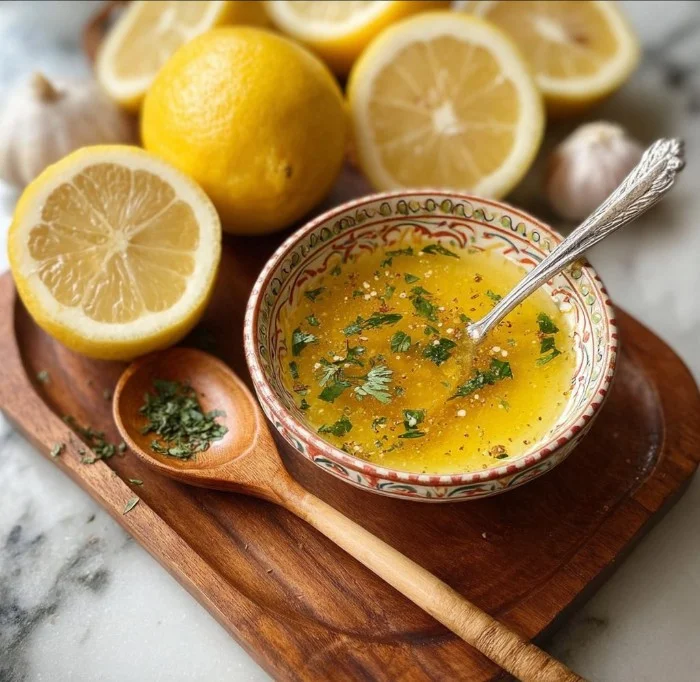Last updated on July 1, 2025
I have a vivid memory from my early cooking days when I decided to whip up a fresh salad for friends who were coming over for dinner. I was excited but a little nervous. My salad was looking colorful and beautiful, but when it came to dressing it, I froze. I had always relied on store-bought dressings and the thought of making my own was daunting. Would I get the flavors right? Would it just taste like a sour lemon? That evening turned into a hilarious series of mishaps, but I learned one important lesson: making my own dressing, like my Lemon Vinaigrette, can be incredibly easy and rewarding.
If you’re anything like I was, you may feel a little intimidated when faced with the idea of crafting your own salad dressing. The fear of ruining your meal, not knowing the right balance of flavors, or the thought of complicated steps can make you hesitate. But let me reassure you: making Lemon Vinaigrette is as simple as whisking together a few ingredients. By the end of this blog post, you’ll feel equipped and confident enough to create your own delicious vinaigrette, whether it’s your first attempt or your hundredth!
So roll up your sleeves, gather your ingredients, and let’s get started on this lovely journey to salad bliss.
Table of Contents
Ingredients You’ll Need for Lemon Vinaigrette
When you think of Lemon Vinaigrette, envision a bright, tangy dressing that dances on your taste buds and brings life to any dish. Here’s what you’ll need:
Print
Perfecting Lemon Vinaigrette
- Total Time: 5 minutes
- Yield: About 1/2 cup 1x
Description
This bright and zesty Lemon Vinaigrette adds a fresh burst of flavor to salads, vegetables, and more. Made with simple ingredients like lemon juice, garlic, and olive oil, it’s a quick, versatile dressing that elevates any dish.
Ingredients
Essentials:
- 1/4 cup fresh lemon juice
- 1 small garlic clove, grated
- 1 teaspoon Dijon mustard
- 1/4 teaspoon sea salt (more to taste)
- Freshly ground black pepper, to taste
- 1/4 to 1/3 cup extra virgin olive oil
Optional Add-Ons:
- 1/2 teaspoon honey or maple syrup (optional)
- 1/2 teaspoon fresh or dried thyme (optional)
Substitutions and Shortcuts:
- Use lime juice or vinegar if lemons aren’t available
- Substitute garlic powder for fresh garlic
- Use whole grain or yellow mustard if Dijon isn’t on hand
- Shake ingredients in a jar instead of whisking
Instructions
- Prepare Ingredients: Gather all ingredients and tools. Use a small bowl for whisking or a jar with a lid for shaking.
- Whisk Base: In a bowl, combine lemon juice, grated garlic, Dijon mustard, salt, pepper, and optional honey or maple syrup. Whisk until fully combined.
- Add Olive Oil: While whisking continuously, slowly drizzle in the olive oil until emulsified and the dressing thickens slightly.
- Adjust Flavors: Taste and adjust salt, pepper, and olive oil to your preference. Stir in thyme if using.
- Store: Pour into a jar with a lid. Refrigerate for up to 1 week. Let sit at room temperature and shake before using.
Notes
- Use freshly squeezed lemon juice for the best flavor.
- Great as a salad dressing or drizzled over roasted vegetables or grilled chicken.
- The dressing may solidify in the fridge—bring to room temp before use.
- Prep Time: 5 minutes
- Cook Time: 0 minutes
- Category: Dressing
- Method: No-cook
- Cuisine: American, Mediterranean
Nutrition
- Serving Size: 1 tablespoon
- Calories: 90
- Sugar: 0g
- Sodium: 60mg
- Fat: 9g
- Saturated Fat: undefined
- Unsaturated Fat: undefined
- Trans Fat: undefined
- Carbohydrates: 1g
- Fiber: undefined
- Protein: 0g
- Cholesterol: undefined
Keywords: lemon vinaigrette, lemon salad dressing, homemade vinaigrette, healthy dressing, quick vinaigrette, garlic lemon dressing
Essentials
1/4 Cup Fresh Lemon Juice: Freshly squeezed lemon juice is key here. It provides that zesty zing that elevates your salad or dish. Don’t reach for the bottled stuff; trust me, it makes a difference!
1 Small Garlic Clove, Grated: Garlic adds a wonderful depth to the dressing. Grating it helps release more oils and flavor.
1 Teaspoon Dijon Mustard: This creamy mustard adds a subtle spice and helps with emulsification, allowing the oil and vinegar to combine more smoothly.
1/4 Teaspoon Sea Salt (more to taste): Salt enhances all the flavors. Remember, you can always add more later!
Freshly Ground Black Pepper: A few cracks of fresh black pepper give it that extra family-style kick.
1/4 to 1/3 Cup Extra Virgin Olive Oil: This is the heart of your vinaigrette and contributes rich flavor.
Optional Add-Ons
1/2 Teaspoon Honey or Maple Syrup (optional): Want a hint of sweetness? You can add honey or maple syrup for balance. It’s completely up to your taste preference.
1/2 Teaspoon Fresh or Dried Thyme (optional): Thyme adds a lovely herby note that can enhance your vinaigrette even further. It’s great if you want to surprise your guests with a little something extra.
Substitutions and Shortcuts
If you’re missing an ingredient, don’t worry! Here are some easy substitutions:
- Lemon Juice: If fresh lemons aren’t available, you can use lime juice or even a splash of vinegar, although the flavor will change a bit.
- Garlic: Garlic powder can work in a pinch, though it’s not quite as bright.
- Mustard: If you don’t have Dijon, whole grain mustard or even yellow mustard will do.
And if you don’t feel like whisking it all together, just toss it into a jar with a tight-fitting lid and shake – it’s that easy!
How to Make Lemon Vinaigrette Step-by-Step
Making Lemon Vinaigrette is straightforward and a rewarding process. Let me guide you through it step-by-step so you can confidently make it yourself.
Step 1: Prepare Your Ingredients
First things first, gather all your ingredients. Having everything within reach makes the process smoother and quicker. You’ll need a bowl for whisking or a jar for shaking, depending on your preference.
Step 2: Whisking in a Bowl
In a small bowl, start by combining the fresh lemon juice, grated garlic, Dijon mustard, sea salt, and freshly ground black pepper. If you like a hint of sweetness, drizzle in your honey or maple syrup. Using a whisk, mix these together well. You want to ensure the garlic and mustard are fully incorporated into the lemon juice.
Step 3: Adding the Olive Oil
Now comes the fun part! As you continue whisking, slowly drizzle in the extra virgin olive oil. This step is crucial for emulsification which means combining the oil and water-based ingredients into a smooth, creamy dressing. Keep whisking until everything is beautifully blended – you’ll notice a slight thickening in consistency.
Step 4: Adjusting Flavor
This is your dressing, which means you can tweak it to your liking. Give it a taste. If it’s too tangy for your preference, gradually add more olive oil until it reaches your desired flavor. Don’t forget to sprinkle in some fresh or dried thyme if you’re using it and adjust salt and pepper to taste.
Step 5: Storing Your Vinaigrette
Once you’ve got the dressing just how you like it, it’s time to store it. Transfer your dressing into a jar with a lid for easy pouring and storing in the fridge. It should stay fresh for up to a week. Just remember, olive oil will solidify a bit in the fridge, so let it sit out for a few minutes or give it a little stir before using.
And voilà! You’ve made your homemade Lemon Vinaigrette! Feel free to incorporate this into salads, grilled veggies, or even as a marinade.
Common Mistakes to Avoid
As with any new recipe, there are some pitfalls that beginners might face. Here are a few misunderstandings to watch out for:
Overpowering the Olive Oil
It’s tempting to pour in olive oil without measuring, but that can lead to an unbalanced dressing. Always start with the recommended amount and adjust according to taste.
Using Bottled Lemon Juice
If you want a fresh, delightful taste, opt for freshly squeezed lemon juice. Bottled varieties often have preservatives that can dull the flavor of your dressing.
Skipping the Whisk
Whisking is necessary for creating an emulsified dressing. If you skip this step or don’t whisk enough, your vinaigrette might separate, and no one wants that!
Forgetting to Taste
Remember to taste as you go! Adjusting flavors is part of the fun and ensures the dressing suits your palate.
Quick Wins for Beginner Cooks
Now that you’re feeling more prepared, let’s share some tips to make your cooking experience smoother:
Use Fresh Ingredients
Always choose fresh ingredients when possible. Fresh herbs and citrus significantly enhance the taste of your vinaigrette, making it taste gourmet.
Embrace Your Creativity
Feel free to experiment! You can add different herbs, spices, or even different acids like vinegar to give your dressing a twist. Don’t be afraid to make it your own.
Prepare in Batches
Make a larger batch of your vinaigrette and store it in the fridge so you have it on hand all week. You’ll find yourself reaching for it when preparing quick meals or snacks.
Keep It Simple
Don’t overthink it! Focus on a handful of key flavors that you love, and let them shine. Simplicity often leads to the most delicious results.
Pro-Level Tips for When You’re Ready
Feeling like a pro? Here are some tips to elevate your Lemon Vinaigrette:
Experiment with Flavored Oils
Instead of traditional olive oil, try using flavored oils like garlic-infused or basil-infused oil for an extra layer of flavor.
Create Dressings with Different Acids
Take a leap and substitute lemon juice with orange juice, vinegar, or even a mix of both. Each will impart a different character to your vinaigrette.
Incorporate Unique Ingredients
Think about adding a teaspoon of mustard greens or a splash of yogurt for a creamy twist. Don’t shy away from trying new combinations!
Pairing Suggestions
Once you feel comfortable making your vinaigrette, think about how to use it in different dishes. It can bring salads, roasted vegetables, or even meats to life.
Conclusion & Next Steps
And there you have it! You’ve learned how to create a simple, delicious Lemon Vinaigrette that’s perfect for beginners. It might feel a little intimidating at first, but with practice, you’ll find it easier than you expected. Remember that you can customize it according to your taste, which is the beauty of homemade dressings.
Now that you’re armed with this cozy, classic recipe, the next step is to put it into action. Whip up a batch, drizzle it on your favorite salads, or experiment with marinades for your next dinner. The possibilities truly are endless!
If you enjoyed this recipe or found it helpful, please share it with your friends and family. Happy cooking!
FAQs About Lemon Vinaigrette
What is a good ratio for Lemon Vinaigrette?
A good starter ratio is 3:1 oil to acid. For example, you can use 3 parts olive oil to 1 part lemon juice. You can adjust this based on your taste preferences.
Can I use this Lemon Vinaigrette for something other than salads?
Absolutely! It works wonderfully as a marinade for chicken, a drizzle over grilled vegetables, or even as a finishing touch on fish dishes.
How long can I store Lemon Vinaigrette?
Properly stored in a sealed jar in the fridge, your Lemon Vinaigrette can last up to a week. If it starts to separate, just give it a good shake before using.
Can I make this dressing without Dijon mustard?
Yes, if you don’t have Dijon on hand, you can leave it out or use another type of mustard. Just keep in mind that it will change the flavor slightly.
What can I substitute for honey in the dressing?
If you’re looking for a sweeter touch without honey, consider maple syrup or agave nectar. You can also omit the sweetener altogether if you prefer a tangy vinaigrette.
Looking for more delicious recipes? Follow us on Pinterest and Facebook!





